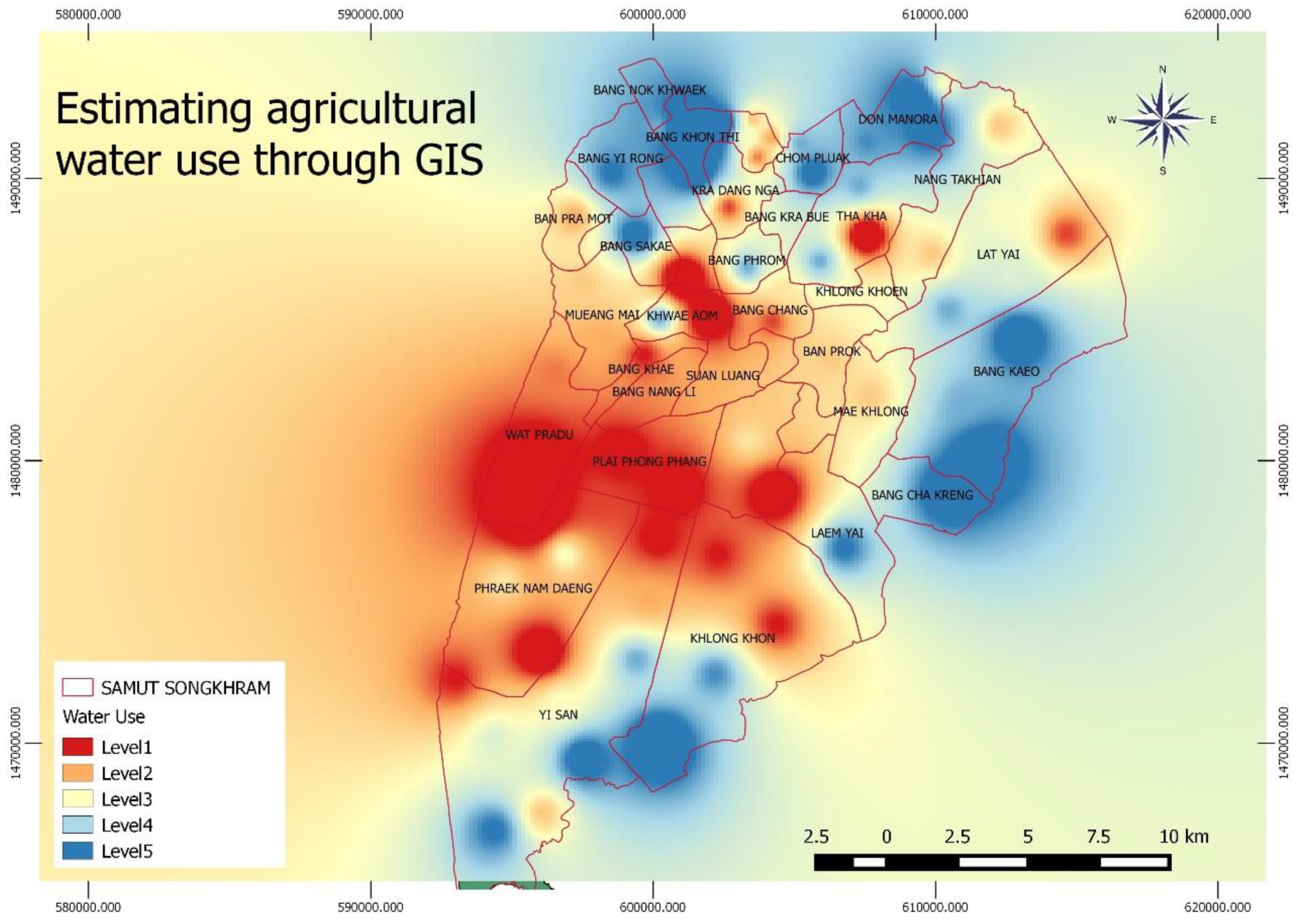Application of Geo-Informatics to Estimate Agricultural Water Use in Samut Songkhram Province, Thailand †
Abstract
:1. Introduction
2. Materials and Methods
3. Results
4. Conclusions
Acknowledgments
References
- Chinvanno, S. Future Climate Change in Thailand. 2004. Available online: http://startcc.iwlearn.org/doc/Doc_thai_4.pdf.Thai (accessed on 15 June 2017).
- Howell, T.A. Enhancing Water Use Efficiency in Irrigated Agriculture. Agron. J. 2001, 93, 281–289. [Google Scholar] [CrossRef]
- UNWWDR (The United Nations World Water Development Report). Water for People, Water for Life/Executive Summary; UNESCO Publishing: Paris, France, 2003; pp. 17–18. [Google Scholar]
- Dyras, I.; Dobesch, H.; Grueter, E.; Perdigao, A.; Tveito, O.E.; Thornes, J.E.; Wel, F.; Bottai, L. The use of geographical information systems in climatology and meteorology: COST 719. Meteorol. Appl. 2005, 12, 1–5. [Google Scholar] [CrossRef]
- Paul, J.G.; Clare, H.P. Introductory Remote Sensing Digital Image Processing and Applications; Routledge: London, UK, 2000. [Google Scholar]
- Diodato, N.; Ceccarelli, M.; Bellocchi, G. GIS-aided evaluation of evapotranspiration at ultiple spatial and temporal climate patterns using geoindicators. Ecol. Indic. 2010, 10, 1009–1016. [Google Scholar] [CrossRef]
- Keith, R.M. Resources Management Information System; Remote Sensing, and Modeling; CRC Press: Boca Raton, FL, USA; Taior & Francis Group: Boca Raton, FL, USA, 2006. [Google Scholar]
- Chen, Y.; Chen, J.; Xevi, E.; Ahmad, M.; Walker, G. GIS-based Spatial Hydrological Zoning for Sustainable Water Management of Irrigation Areas. In Proceedings of the International Congress on Environmental Modelling and Software, Ottawa, ON, USA, 5–8 July 2010. [Google Scholar]
- Osotspa, Y.; Panichsakpatana, S.; Wongmaneeroj, A.; Thongju, C. Introduction to Soil Science; Kasetsart University: Bangkok, Thailand, 1998. [Google Scholar]
- Wangwongwirot, N. Hydrology; King Mongkut’s University of Technology Thonburi: Bangkok, Thailand, 2008. [Google Scholar]
- Homhuan, S.; Narongrit, C. Soil Water Modeling Using Geographic Information System. J. Remote Sens. GIS Assoc. Thail. 2004, 5, 1–14. [Google Scholar]
- Yang, Y.; Uddstrom, M.; Revell, M.; Andrews, P.; Oliver, H.; Turner, R.; Carey-Smith, T. Numerical simulations of effects of soil moisture and modification by mountains over New Zealand in summer. Mon. Weather Rev. 2011, 139, 494–510. [Google Scholar] [CrossRef]

Publisher’s Note: MDPI stays neutral with regard to jurisdictional claims in published maps and institutional affiliations. |
© 2018 by the author. Licensee MDPI, Basel, Switzerland. This article is an open access article distributed under the terms and conditions of the Creative Commons Attribution (CC BY) license (https://creativecommons.org/licenses/by/4.0/).
Share and Cite
Phonphan, W. Application of Geo-Informatics to Estimate Agricultural Water Use in Samut Songkhram Province, Thailand. Proceedings 2018, 2, 1397. https://doi.org/10.3390/proceedings2221397
Phonphan W. Application of Geo-Informatics to Estimate Agricultural Water Use in Samut Songkhram Province, Thailand. Proceedings. 2018; 2(22):1397. https://doi.org/10.3390/proceedings2221397
Chicago/Turabian StylePhonphan, Walaiporn. 2018. "Application of Geo-Informatics to Estimate Agricultural Water Use in Samut Songkhram Province, Thailand" Proceedings 2, no. 22: 1397. https://doi.org/10.3390/proceedings2221397
APA StylePhonphan, W. (2018). Application of Geo-Informatics to Estimate Agricultural Water Use in Samut Songkhram Province, Thailand. Proceedings, 2(22), 1397. https://doi.org/10.3390/proceedings2221397



